js中Functions以及ES6箭头函数的详细分析
本篇文章给大家带来的内容是关于js中Functions以及ES6箭头函数的详细分析,有一定的参考价值,有需要的朋友可以参考一下,希望对你有所帮助。
简介
JavaScript中的所有内容都发生在函数中。
函数是一个代码块,可以定义一次并随时运行。
函数可以选择接受参数,并返回一个值。
JavaScript中的函数是对象,一种特殊的对象:函数对象。
另外,函数被称为第一类函数,因为它们可以被赋值给一个值,它们可以作为参数传递并用作返回值。
句法
让我们从“旧的”,ES6 / ES2015之前的语法开始。这是一个函数声明:
function dosomething(foo) {
// do something
}(现在,在ES6 / ES2015世界中,被称为常规函数)
函数可以分配给变量(这称为函数表达式):
const dosomething = function(foo) {
// do something
}命名函数表达式类似,但在堆栈调用跟踪中更好用,这在发生错误时很有用 - 它保存函数的名称:
const dosomething = function dosomething(foo) {
// do something
}ES6 / ES2015引入了箭头函数,在使用内联函数时,特别适合用作参数或回调函数:
const dosomething = foo => {
//do something
}箭头函数与上面的其他函数定义有很大的不同,我们稍后会解释。
参数
一个函数可以有一个或多个参数。
const dosomething = () => {
//do something
}
const dosomethingElse = foo => {
//do something
}
const dosomethingElseAgain = (foo, bar) => {
//do something
}从ES6 / ES2015开始,函数可以具有参数的默认值:
const dosomething = (foo = 1, bar = 'hey') => {
//do something
}这允许您在不填充所有参数的情况下调用函数:
dosomething(3) dosomething()
ES2018引入了参数的尾随逗号,这个功能有助于减少因移动参数时丢失逗号而导致的错误(例如,移动中间的最后一个):
const dosomething = (foo = 1, bar = 'hey') => {
//do something
}
dosomething(2, 'ho!')您可以将所有参数包装在一个数组中,并在调用函数时使用spread运算符:
const dosomething = (foo = 1, bar = 'hey') => {
//do something
}
const args = [2, 'ho!']
dosomething(...args)当使用许多参数的时候,记住这些参数可能很困难。这里可以使用对象,解构保留参数名称:
const dosomething = ({ foo = 1, bar = 'hey' }) => {
//do something
console.log(foo) // 2
console.log(bar) // 'ho!'
}
const args = { foo: 2, bar: 'ho!' }
dosomething(args)返回值
每个函数都返回一个值,默认情况下为“undefined”。

任何函数在其代码行结束时,或者当执行流找到return关键字时终止。
当JavaScript遇到此关键字时,它退出函数执行并将控制权交还给其调用者。
如果传递一个值,则该值将作为函数的结果返回:
const dosomething = () => {
return 'test'
}
const result = dosomething() // result === 'test'您只能返回一个值。
要_模拟_返回多个值,您可以返回对象文字或数组,并在调用时使用解构赋值功能。
使用数组:
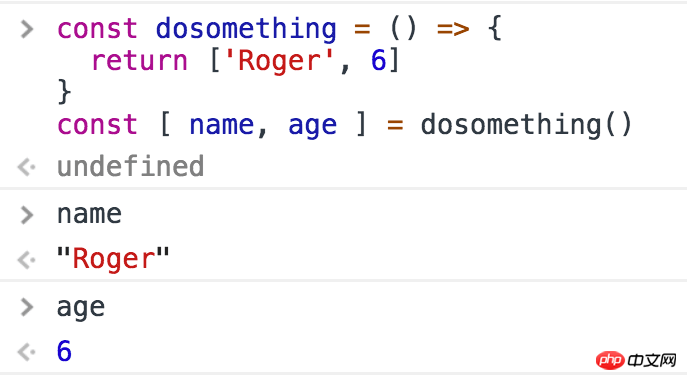
使用对象:
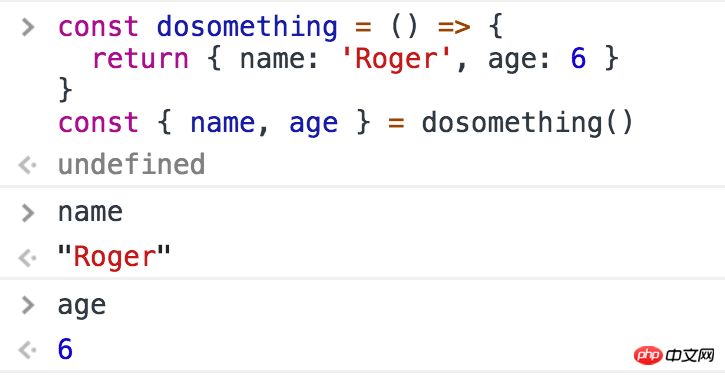
嵌套函数
可以在其他函数中定义函数:
const dosomething = () => {
const dosomethingelse = () => {}
dosomethingelse()
return 'test'
}嵌套函数的作用域是外部函数,不能从外部调用。
对象方法
当用作对象属性时,函数称为方法:
const car = {
brand: 'Ford',
model: 'Fiesta',
start: function() {
console.log(Started)
}
}
car.start()箭头函数中的this
当箭头函数与常规函数用作对象方法时,有一个重要的行为。考虑这个例子:
const car = {
brand: 'Ford',
model: 'Fiesta',
start: function() {
console.log(Started ${this.brand} ${this.model})
},
stop: () => {
console.log(Stopped ${this.brand} ${this.model})
}
}stop()方法不能像你期望的那样工作。
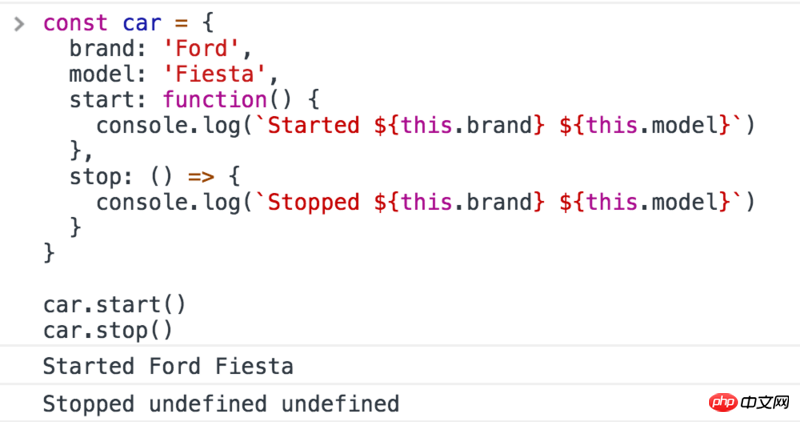
这是因为this的处理在两个函数声明样式中是不同的。箭头函数中的this指的是封闭函数上下文,在本例中是window对象
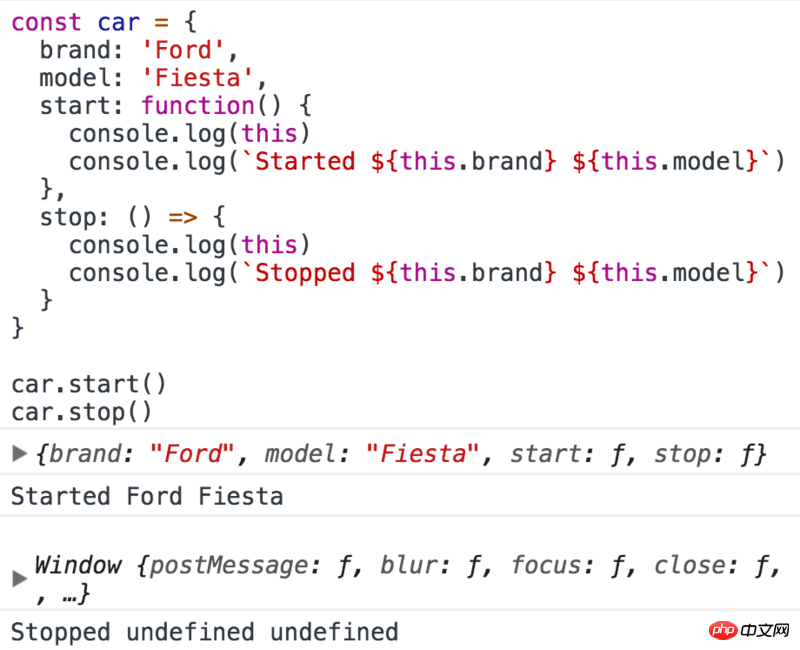
this,使用function()引用宿主对象
这意味着箭头函数不适合用于对象方法和构造函数(箭头函数构造函数实际上会在调用时引发TypeError)。
IIFE,立即调用函数表达式
IIFE是一个在声明后立即执行的功能:
;(function dosomething() {
console.log('executed')
})()您可以将结果分配给变量:
const something = (function dosomething() {
return 'something'
})()它们非常方便,因为您无需在定义后单独调用该函数。
Function 挂载
执行代码之前的JavaScript会根据某些规则对其进行重新排序。
会将函数移动到其范围的顶部。这就是下面例子不会报错的原因;
dosomething()
function dosomething() {
console.log('did something')
}
在内部,JavaScript在调用之前移动函数,以及在同一范围内找到的所有其他函数:
function dosomething() {
console.log('did something')
}
dosomething()现在,如果你使用命名函数表达式,因为你正在使用变量,会发生不同的事情。变量声明被提升,但不是值,因此不是函数。
dosomething()
const dosomething = function dosomething() {
console.log('did something')
}不会工作:

这是因为内部发生的事情是:
const dosomething
dosomething()
dosomething = function dosomething() {
console.log('did something')
}“let”声明也是如此。var声明也不起作用,但是报的不是同样的错误:
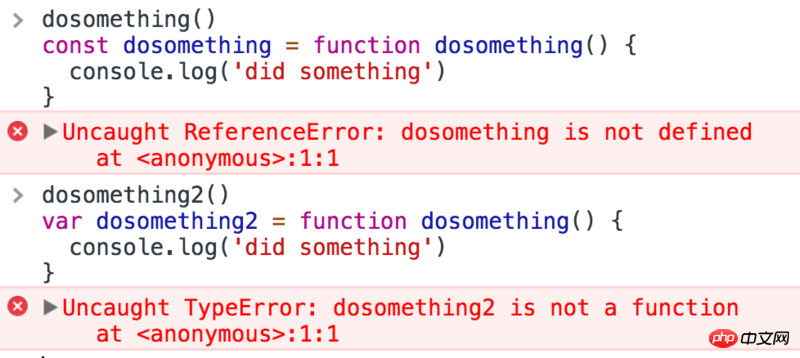
这是因为var声明被提升并用undefined作为值初始化,而const和let被提升但未初始化。
相关推荐:
Atas ialah kandungan terperinci js中Functions以及ES6箭头函数的详细分析. Untuk maklumat lanjut, sila ikut artikel berkaitan lain di laman web China PHP!

Alat AI Hot

Undresser.AI Undress
Apl berkuasa AI untuk mencipta foto bogel yang realistik

AI Clothes Remover
Alat AI dalam talian untuk mengeluarkan pakaian daripada foto.

Undress AI Tool
Gambar buka pakaian secara percuma

Clothoff.io
Penyingkiran pakaian AI

Video Face Swap
Tukar muka dalam mana-mana video dengan mudah menggunakan alat tukar muka AI percuma kami!

Artikel Panas

Alat panas

Notepad++7.3.1
Editor kod yang mudah digunakan dan percuma

SublimeText3 versi Cina
Versi Cina, sangat mudah digunakan

Hantar Studio 13.0.1
Persekitaran pembangunan bersepadu PHP yang berkuasa

Dreamweaver CS6
Alat pembangunan web visual

SublimeText3 versi Mac
Perisian penyuntingan kod peringkat Tuhan (SublimeText3)

Topik panas
 1392
1392
 52
52
 36
36
 110
110
 Sempadan Jadual dalam HTML
Sep 04, 2024 pm 04:49 PM
Sempadan Jadual dalam HTML
Sep 04, 2024 pm 04:49 PM
Panduan untuk Sempadan Jadual dalam HTML. Di sini kita membincangkan pelbagai cara untuk menentukan sempadan jadual dengan contoh Sempadan Jadual dalam HTML.
 Jadual Bersarang dalam HTML
Sep 04, 2024 pm 04:49 PM
Jadual Bersarang dalam HTML
Sep 04, 2024 pm 04:49 PM
Ini ialah panduan untuk Nested Table dalam HTML. Di sini kita membincangkan cara membuat jadual dalam jadual bersama-sama dengan contoh masing-masing.
 HTML jidar-kiri
Sep 04, 2024 pm 04:48 PM
HTML jidar-kiri
Sep 04, 2024 pm 04:48 PM
Panduan untuk HTML margin-kiri. Di sini kita membincangkan gambaran keseluruhan ringkas tentang HTML margin-left dan Contoh-contohnya bersama-sama dengan Pelaksanaan Kodnya.
 Susun Atur Jadual HTML
Sep 04, 2024 pm 04:54 PM
Susun Atur Jadual HTML
Sep 04, 2024 pm 04:54 PM
Panduan untuk Susun Atur Jadual HTML. Di sini kita membincangkan Nilai Susun Atur Jadual HTML bersama-sama dengan contoh dan output n perincian.
 Pemegang Tempat Input HTML
Sep 04, 2024 pm 04:54 PM
Pemegang Tempat Input HTML
Sep 04, 2024 pm 04:54 PM
Panduan untuk Pemegang Tempat Input HTML. Di sini kita membincangkan Contoh Pemegang Tempat Input HTML bersama-sama dengan kod dan output.
 Memindahkan Teks dalam HTML
Sep 04, 2024 pm 04:45 PM
Memindahkan Teks dalam HTML
Sep 04, 2024 pm 04:45 PM
Panduan untuk Memindahkan Teks dalam HTML. Di sini kita membincangkan pengenalan, cara teg marquee berfungsi dengan sintaks dan contoh untuk dilaksanakan.
 Senarai Tertib HTML
Sep 04, 2024 pm 04:43 PM
Senarai Tertib HTML
Sep 04, 2024 pm 04:43 PM
Panduan kepada Senarai Tertib HTML. Di sini kami juga membincangkan pengenalan senarai dan jenis Tertib HTML bersama-sama dengan contoh mereka masing-masing
 Butang onclick HTML
Sep 04, 2024 pm 04:49 PM
Butang onclick HTML
Sep 04, 2024 pm 04:49 PM
Panduan untuk Butang onclick HTML. Di sini kita membincangkan pengenalan, kerja, contoh dan onclick Event masing-masing dalam pelbagai acara.




